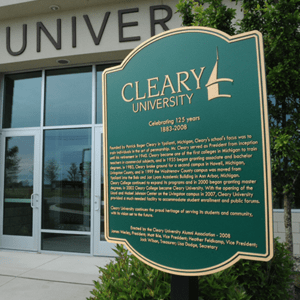At Cleary, the Cleary Mind™ serves as an overarching framework across all academic and co- curricular programs for what is expected during a student’s tenure at the University and guided by a set of learning goals referred to as the Cleary Mind Attributes seeks to develop in students the ability to engage in the world, to be critical thinkers, creative problem solvers, to integrate empirical analysis and ethics, to seek out and create new knowledge and technologies, and to adapt to new situations. The nature of these opportunities and how they are offered through the integration of student centered in-class and out- of-class learning experiences which are characterized by active and engaged learning exemplifies the Cleary Mind and what is expected of Cleary graduates.
Cleary’s plan for assessing student learning is dynamic and grounded in the university’s mission and strategic plan, and upholds the philosophy that student learning assessment should be an integrated, ongoing component of academic life and the student experience.
Cleary University adopted the eight attributes of The Cleary Mind™ as a shared set of competencies for learning across academic programs. These broad categories encompass many of the goals and purposes shared by Cleary University’s academic program and co-curricular experiences.
Program level assessment focuses on what and how an academic program is contributing to the learning and development of students as a group.
The purpose of an academic program assessment plan is to facilitate continuous program level improvement. Program assessment plans provide faculty and instructors with a clear understanding of how the program is assessed (e.g., what is being measured and when, who will collect the data and how the results will be used) with the ultimate goal to foster ongoing and systematic evaluation of student learning. More specifically assessment plans clearly define the educational mission and the outcomes students are expected to demonstrate as a result of the program. Plans also show the alignment of course curricula to the stated program outcomes, describe how the outcomes will be assessed and outline how results will be used.
At Cleary University, undergraduate, graduate, and the general education program must have an active assessment plan. Quality program assessment plans should:
Assessment Plan Template – Undergraduate Program – A template for creating an assessment plan for an undergraduate degree program.
Assessment Plan Template – Graduate Program – A template for creating an assessment plan for a graduate degree program.
Current Cleary Academic Program Assessment Plans
By providing a telephone number and submitting this form you are consenting to be contacted by SMS text message. Message & data rates may apply. You can reply STOP to opt-out of further messaging.
Cleary graduates use their business arts education to become the employees, entrepreneurs, and leaders who transform the marketplace…and the world.
Follow Us
HOWELL
DETROIT
SUMMER HOURS: (May 12 to Aug. 4)
Mon-Thur | 7am to 5pm
Fri-Sun | Closed
